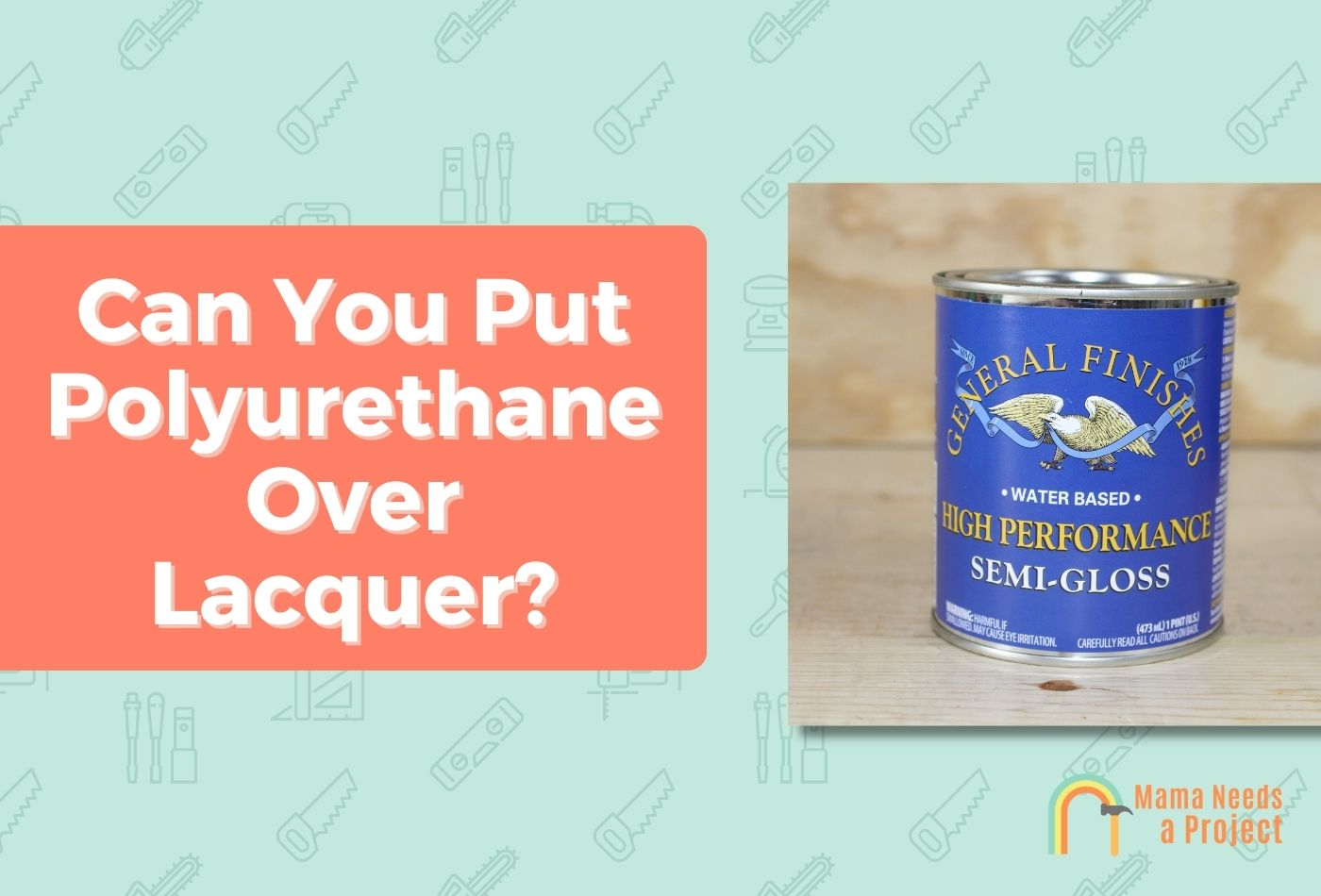Can You Put Polyurethane Over Lacquer? (Quick Answer!)
In its natural state, wood is one of the most beautiful and timeless materials for furniture, crafts, and many other purposes. However, while wood is beautiful, it’s also delicate and has the potential to scratch, dent, and bruise easily. So t’s often necessary to give wood products a protective coat of lacquer or polyurethane.
Because lacquer and polyurethane look and feel similar and perform the same protective function, people often wonder if they can put polyurethane over lacquer to create double protection.
In this post, I’ll answer the question, “can you put polyurethane over lacquer?” and explore what the best protective layer is for lacquer in the event that polyurethane doesn’t fit the bill. Let’s dig in!
- No, you shouldn’t put polyurethane over lacquer because it doesn’t adhere well and can peel off over time.
- If you’re looking for added protection, you can add shellac over a lacquer finish.
Can I Put Polyurethane Over Lacquer?
The short answer to this question is that NO, you cannot put polyurethane over lacquer. While polyurethane and lacquer are both liquids that perform the same function, they are very different and incompatible materials.
If you try to put poly over lacquer, the poly won’t properly adhere, and it will pull away from the wood surface and cause peeling. The only way that you can safely use polyurethane on something that has a coat of lacquer on top of it is to completely sand and remove the lacquer before applying polyurethane.
The same rule applies to putting lacquer on top of polyurethane. Unless you sand and remove the poly first, the lacquer will not adhere properly and will result in peeling.
Different Types of Lacquer
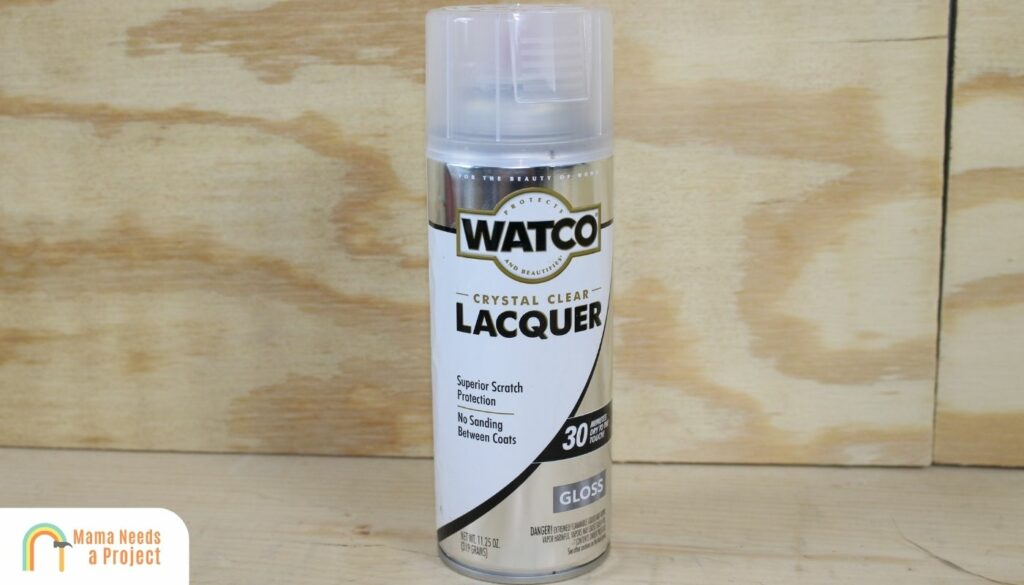
Lacquer is a very thin but durable finish that gets applied to wood surfaces for added protection. Because lacquer provides very thin coats, you may need to apply more than one to get the job done.
There are several different types of lacquer that offer a different finish and appearance based on the type you choose. Additionally, lacquer can either be found naturally, as a product of tree sap resin, or it can get synthetically produced in a lab.
Acrylic Lacquer
Acrylic lacquer, which consists of a clear plastic resin, thermoplastic polymer, and binders that hold it together, is one of the most popular types of lacquer on the market. It’s slightly thicker than other types of lacquer, which means it offers a thicker protective layer, and you may not need multiple coats.
In addition to its thickness, the main reason people like acrylic lacquer is because it stays clear after application, as opposed to other types of lacquer that tend to yellow or discolor over time. Acrylic lacquers are also more flexible and less brittle than other types of lacquer, which reduces the chances of damage.
On the downside, because of its thickness, you may need a lacquer thinner to use this product in a sprayer. Acrylic lacquers also tend to be more expensive than other options because of the unique benefits it offers.
Catalyzed Lacquer
Catalyzed lacquer is perhaps the most intricate and complicated type of lacquer on the market. It’s a unique combination of urea resins and nitrocellulose resins, making it durable, pliable, and highly protective.
Unlike other types of lacquer, catalyzed lacquer doesn’t naturally cure on its own. Instead, you will have to add an acid catalyst that you mix into the lacquer so that it starts to cure after it has been dispensed. For obvious reasons, catalyzed lacquer is so named because you have to add the curing catalyst.
While this can make catalyzed lacquer finishes slightly more complicated to use, many people think it’s worth the trouble thanks to this lacquer’s numerous benefits. It’s one of the more durable and waterproof types of lacquer, and if you’re worried about the idea of mixing in your own catalyst, you can also purchase it pre-catalyzed.
Water-Based Lacquer
One of the biggest knocks on lacquer and other protective finishes is that they are highly combustible, toxic, and bad for the environment. As a result, lacquer manufacturers were compelled to create an option that is less combustible, non-toxic, and more eco-friendly – water-based lacquer.
The great thing about water-based lacquer is that you don’t have to compromise quality for these benefits. It will still provide a beautiful finish to wood surfaces and offer adequate protection.
While it’s not completely non-combustible, water-based lacquer is much less prone to catching fire, making it the preferred option in dry, hot climates. Additionally, even though it isn’t considered as toxic as other lacquers, you should still avoid inhaling water-based lacquers directly and wear protective gear when you’re applying it.
Nitrocellulose Lacquer
The last type of lacquer we’ll look at also happens to be the most popular – nitrocellulose lacquer. In addition to being the most popular and readily available, nitrocellulose lacquer is the OG of the lacquer world, as it’s been around the longest.
Consisting of a combination of nitric and sulfuric acids and a plant base, such as cotton, nitrocellulose lacquer is also the most affordable option available. It’s a fast-drying liquid that adheres easily and readily to all wood surfaces, and you’ll often need only one layer due to its thickness.
Although it remains the cheapest and most popular option, nitrocellulose lacquer isn’t necessarily the best. Over time, its ingredients cause it to discolor and turn a yellowish color, which will take away from the natural beauty of the wood surface it’s protecting.
Additionally, nitrocellulose lacquer is very heat sensitive and prone to cracking, scratches, and peeling if it’s subjected to heat for too long. As such, you should think long and hard about whether or not nitrocellulose lacquer is the best option for you.
How to Apply Polyurethane Over Lacquer
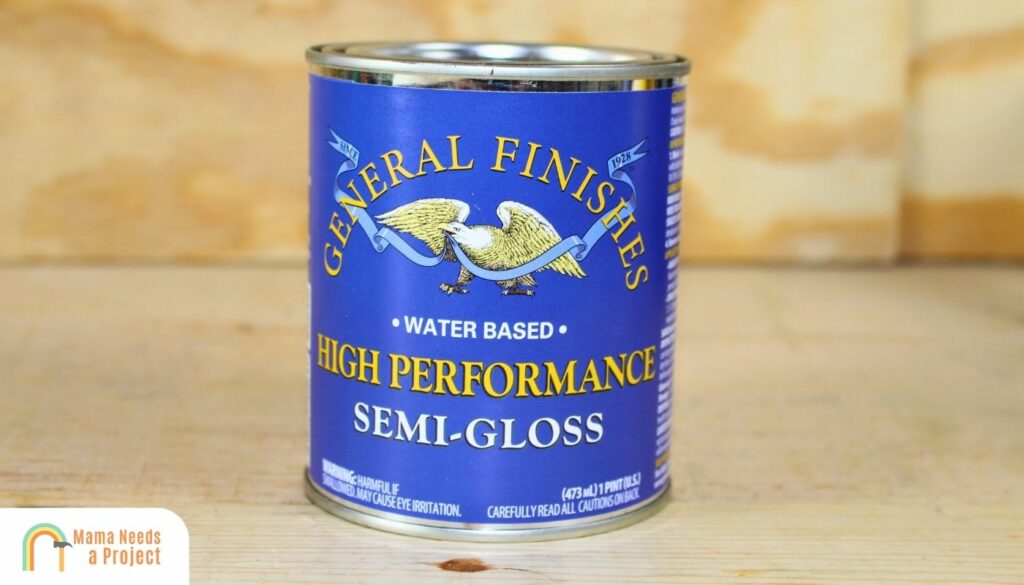
While lacquer provides ample protection for wood surfaces, its thin coat isn’t always enough for long-term protection. As such, it’s sometimes necessary to add an extra protective coat on top of the lacquer.
Unfortunately, you can’t put polyurethane directly on top of lacquer because the two are incompatible and will ruin whatever you’re trying to protect. However, if you’re dead set on using polyurethane on something coated with lacquer, here’s what you need to do.
1. Remove the Lacquer
The only way to apply polyurethane on something previously coated in lacquer is to remove the lacquer first. You can do this with light sanding using a hand sander or sandpaper, preferably with 180 to 220 grit.
If this sandpaper grit is too fine to remove the lacquer, use a rougher one, keeping in mind that you don’t want to damage the wood surface beneath the lacquer.
2. Clean the Wood Surface
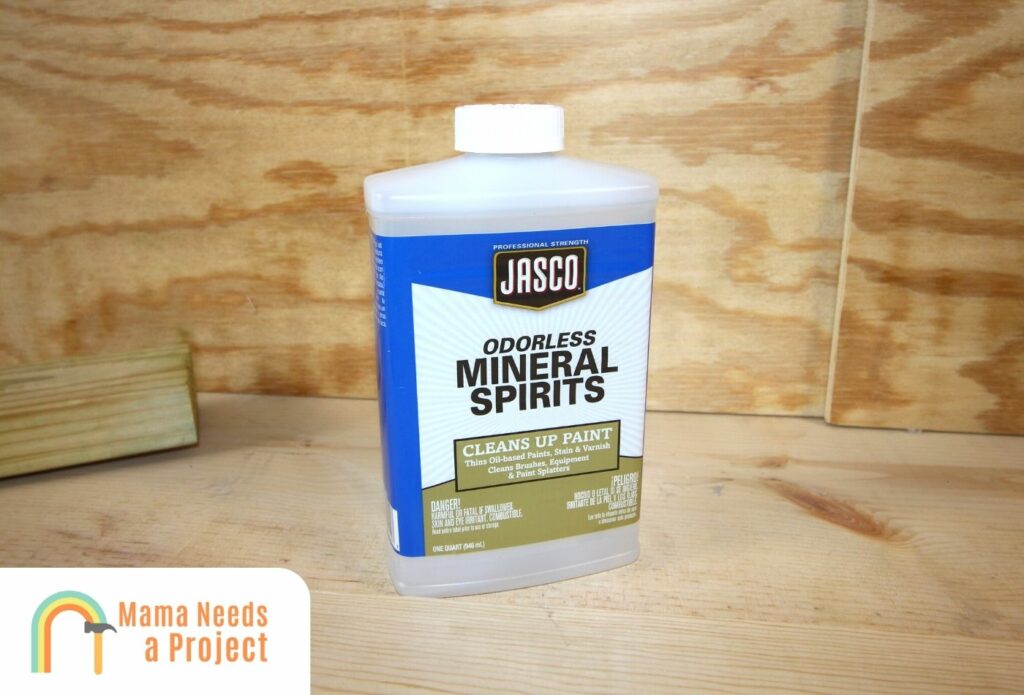
With the lacquer removed, take a shop vac and sweep away any dust and remnants from on top of the wood surface. Be sure to wipe it down with a damp rag afterward, as every speck of dust left behind will reveal itself when you apply the polyurethane coat.
3. Apply the Polyurethane
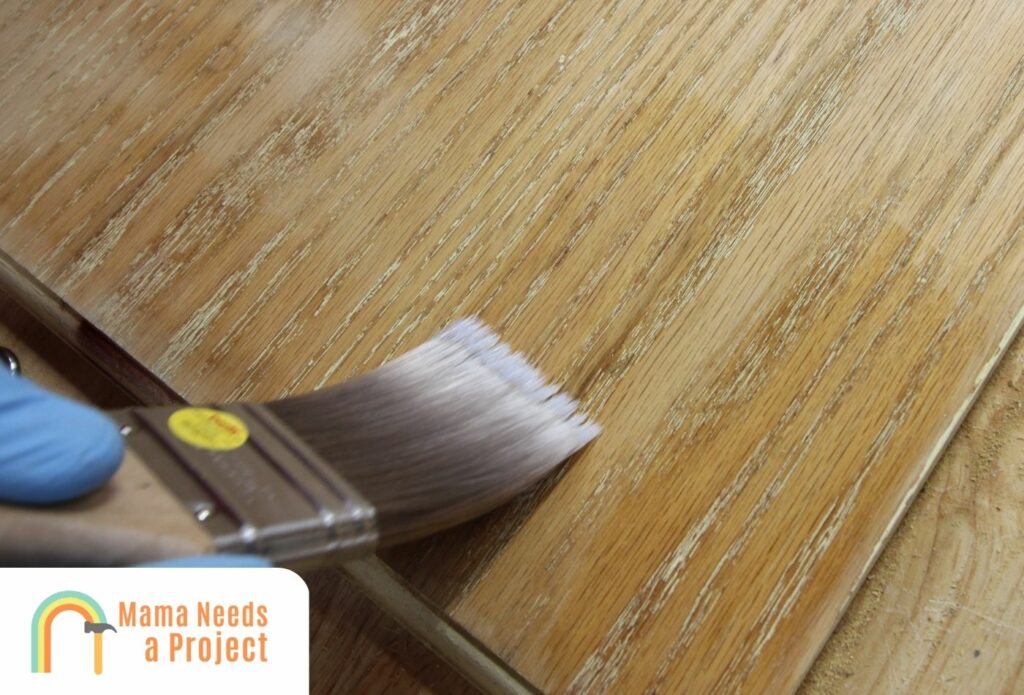
After the wood surface has had time to dry, you’re ready to apply the polyurethane. If you’re a DIYer and don’t want to spend money on a sprayer, you can apply the poly with a paintbrush. Make sure to paint with the wood grain with your brush strokes so that it applies evenly.
If you have a paint sprayer handy, you can use it to apply water-based polyurethane, as it’s slightly thinner than oil-based polyurethane. You can also add a thinning agent to the poly so that you can apply either one with a sprayer.
4. Additional Option: Add a Layer of Sealcoat
If you don’t want to go to the trouble of sanding away the lacquer, you can also opt for a different route. You can add a seal coat directly to the lacquer, then apply a coat of polyurethane on top of the seal coat.
The seal coat will bind to both the lacquer and the polyurethane while offering a buffer between the two so they aren’t in direct contact with one another. However, going this route is usually more trouble than it’s worth and isn’t a good option if the lacquer coating is discolored or damaged because the seal coat won’t hide or repair these issues.
What is the Best Way to Protect Lacquer?
Rather than going to the trouble of sanding away lacquer or applying a seal coat buffer, the best way to protect lacquer is to use alkyd varnish. Alkyd varnish adheres directly and easily to all types of lacquer and consists of polyester resin.
Alkyd varnish also won’t take away from the aesthetics of natural wood surfaces because it looks very similar to lacquer. It’s also easier to make repairs to alkyd varnish than it is to polyurethane or additional coats of lacquer.
How to Apply Alkyd Varnish
The nice thing about using alkyd varnish for protecting lacquer is that it’s very easy to apply as long as you follow these instructions.
Choose the Right Type of Alkyd Varnish
Alkyd varnish comes in a variety of colors and finishes. Therefore, it’s important to choose an option that looks as similar to your lacquer as possible. Otherwise, it could cause discoloring and take away from the finished product.
Ensure the Lacquer is Fully Cured
It’s vital that you give the lacquer enough time to completely cure before applying varnish. This means letting the lacquer sit for anywhere from a week to a month, depending on the type of lacquer you used.
Rough the Surface Slightly
Once the lacquer has cured, you’ll want to slightly rough up the surface of the furniture by rubbing it with 400-grit sandpaper. This will allow the alkyd varnish to better adhere to it and make for a better finish. Keep in mind that you don’t have to be nearly as aggressive or thorough with this sanding process as you would need to be if you were applying polyurethane.
Clean the Wood Surface
Next, use a damp rag to clean the wood surface and eliminate any dust or residue.
Apply your Varnish
Once the wood is dry, you can go ahead and apply your varnish using a brush or foam roller. You can add multiple coats if you want to, but make sure that each coat has time to dry before applying the next.
While it’s ok to put alkyd varnish on top of lacquer, you should never put lacquer on top of varnish. Lacquer has stronger chemicals and could eat through the varnish below, resulting in damage and discoloration.
Is Polyurethane Better Than Lacquer?
Since you can only use one or the other, the next question on most people’s minds is which option is right for them. Polyurethane and lacquer are both liquids that you apply to the top of wood surfaces to protect them from damage, scratches, and dents.
In general, lacquer is preferred by professionals and hardcore DIYers because you can apply it faster and easier when you have the right tools. Because it’s thinner than polyurethane, you can apply lacquer using a paint sprayer, making for a faster, easier, and more even coating experience.
Polyurethane, on the other hand, is preferable for DIYers because you can use a cheap, natural bristle brush or paintbrush to apply it. While you can optionally use a sprayer, the polyurethane is too thick, so you’ll have to use a thinner first.
Ultimately, polyurethane provides a thicker protective coat than lacquer and will hide more blemishes than a single layer of lacquer. Lacquer, on the other hand, provides a cleaner, clearer finish which allows you to get a better picture of the wood’s natural surface.
As long as you know what you’re doing and have the right tools for the job, however, you can use either option for protective purposes.
Check out the video below to learn how to get the perfect finish on any project!
FAQs
How many coats of lacquer do you need to put on wood?
Because lacquer is fine and thin, you may need to apply more than one coat. Ideally, three coats of lacquer is enough to provide a beautiful finish and adequate protection and to prevent discoloration.
What kind of finish should you put over lacquer?
Alkyd varnish is the only type of finish that you can safely put over lacquer.
Is it better to use polyurethane or lacquer?
You can safely use polyurethane or lacquer to protect furniture. Lacquer is usually cheaper and dries faster, but polyurethane is thicker and doesn’t have a risk of discoloration.
Final Thoughts
Applying polyurethane directly on top of lacquer will cause the finish underneath to peel and pull away from the wood. As a result, you will need to completely remove each coat of finish, which risks damaging the wood, and start from scratch.
If you want to add a protective layer of finish on top of lacquer, you should not resort to using polyurethane unless you completely remove the lacquer first. Instead, it’s best to cover the lacquer with more lacquer or an alkyd varnish.


